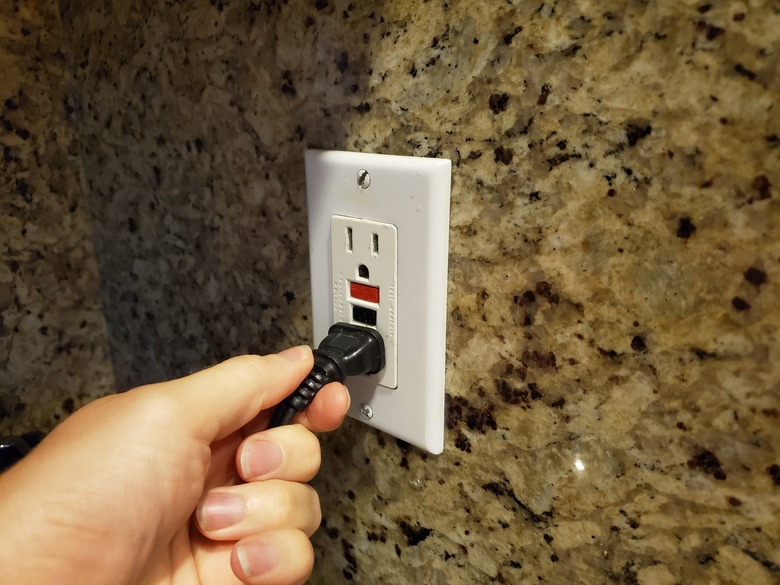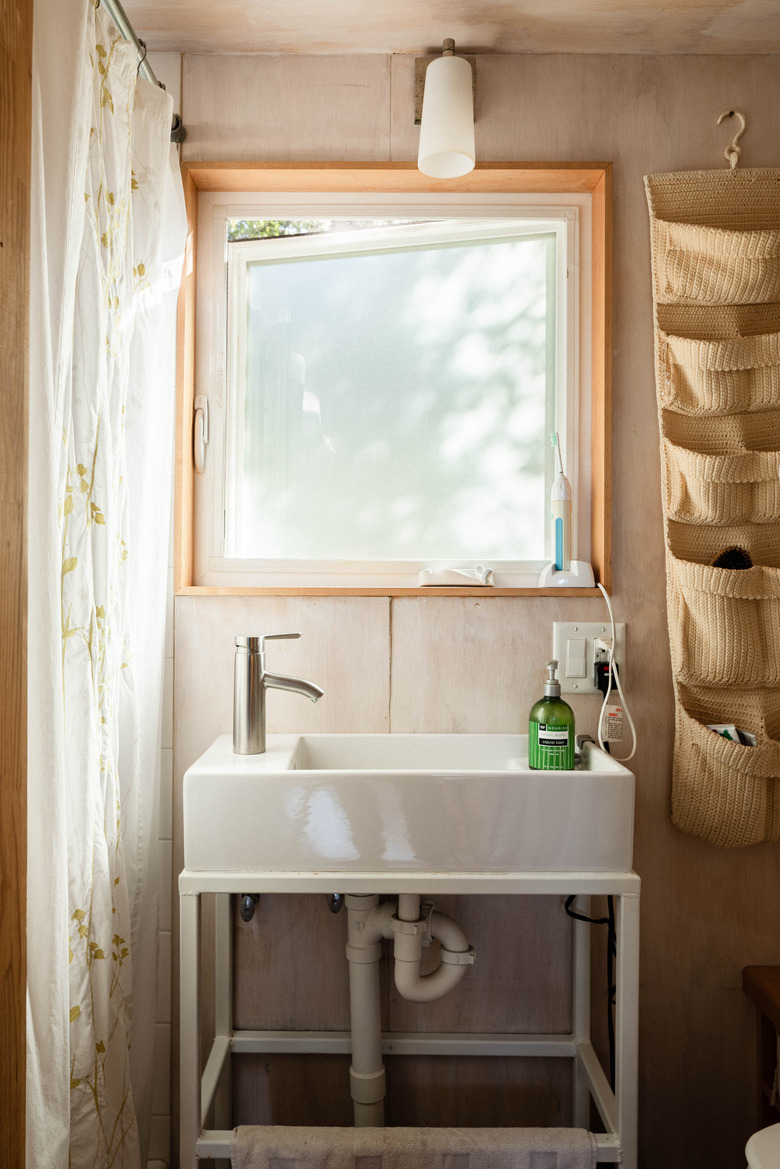Everything You Need To Know About Bathroom GFCI Outlets
We may receive a commission on purchases made from links.
By now, everyone is familiar with the bathroom GFCI outlet, but its history isn't that long, and the National Electrical Code (NEC) was slow to adopt it. Invented in 1961 by University of California engineering professor Charles Dalziel, the ground fault circuit interrupter (GFCI) made its first appearance in the NEC in 1971— just after the moon landing — and it wasn't required in bathrooms until 1975. Today, there are few rooms in the house in which GFCIs aren't required, but because code changes don't apply to wiring that predates the changes, many older homes still don't have them.
If yours is a house that doesn't have GFCI protection, either in the form of outlets or circuit breakers, you're missing out on an important technology that saves lives and prevents fires. The bathroom GFCI is perhaps the most important one in the house because everyone uses the bathroom, and it's one of the places where ground faults are most likely to occur. It's actually fairly easy to provide GFCI protection for the bathroom, and while the most effective strategy involves installing circuit breakers, you can do it without working in the electrical panel.
What Is a Ground Fault?
What Is a Ground Fault?
Long before GFCIs came on the scene, the NEC required all household circuitry to be grounded, which prevented shocks while flipping light switches and plugging in appliances. The path provided by the ground wire prevents residual electricity from collecting where it isn't supposed to, such as on switch toggles and frayed appliance cords, by directing it to the earth, which is the largest receptacle for stray electricity available.
If damaged conductor insulation or a faulty terminal allows a hot wire to come in contact with the ground wire or a grounded metal electrical box, the result is an electrical current surge that can cause electrocution or start a fire. That's called a ground fault.
A ground fault can also occur if a person touches an exposed wire and creates a path to ground, and it can cause a severe electrical shock or even electrocution. You may have heard stories of people being electrocuted while standing in bare feet on a wet floor or in the bathtub while holding a hair dryer with insufficient electrical insulation. They caused a ground fault by providing a path for electricity to flow, and that's the type of accident a GFCI receptacle is designed to prevent.
How GFCI Outlets Protect You
How GFCI Outlets Protect You
A GFCI outlet or circuit breaker contains a sensor that detects the current surge of a ground fault, and it has a breaker that switches off the power, usually in as little as 0.25 seconds. That's still enough time for a shock to occur, but because the shock isn't a prolonged one, it's less likely to cause injury or start a fire.
The bathroom GFCI outlet is recognizable by the two pushbuttons on its face. On older GFCI receptacles, you'll likely see a black test button on top and a red reset button on the bottom. New models have buttons that are the same color as the receptacle and simply have the words "test" and "reset" imprinted on the buttons. When you press the test button, the breaker trips so you know your bathroom GFCI outlet is working. The bottom reset button pops out after tripping, and you reset the outlet when you push it back in until it clicks.
Ways to Get GFCI Protection
Ways to Get GFCI Protection
The first and most expensive way to get ground fault protection in the bathroom is to replace all the electrical outlets with GFCI receptacles. This is usually unnecessary, however, because there are two easier options that are just as effective.
One is to install a GFCI circuit breaker in the electrical panel to control the outlet circuit, which must be dedicated to the bathroom to satisfy the code requirements. Once the breaker is in place, you can install standard 20-amp outlets in the bathroom, and they will all be GFCI protected by the breaker. Unlike a standard breaker, a GFCI breaker has a neutral wire that connects to the neutral bus in the panel, so if you aren't comfortable doing this yourself, call a licensed electrician to install it.
The other option is even easier, but it may require some circuit detective work on your part. The bathroom outlets are daisy-chained together, and if you can locate the first one in the chain, which may or may not be closest to the electrical panel, all you have to do is replace that outlet with a GFCI. That outlet will then protect all the ones that come after it in the circuit. A DIYer can identify the outlet by turning off the circuit breaker, disconnecting the prime suspect outlet, turning the breaker back on and verifying that all the other outlets lose power. If not, try another outlet.
Installing a Bathroom GFCI Outlet
Installing a Bathroom GFCI Outlet
When installing a GFCI outlet, keep in mind that a GFCI outlet differs from a standard one in an important way. Both have two hot terminals, two neutral terminals, and a ground terminal. On a standard outlet, the two hots are interchangeable with each other, as are the two neutrals, but on a GFCI outlet, they aren't.
One pair of terminals, called the LINE terminals, are for the incoming circuit wire, and the other pair, the LOAD terminals, are for daisy-chaining outlets farther down the circuit. If you mix these up, the outlet will still work, but it won't provide ground fault protection.
1. Turn Off the Power
Locate the breaker for the circuit and turn it off. It's good practice to test the wires with a voltage tester to make sure they're dead before you touch anything. Even after checking, you should wear rubber gloves and use insulated tools for safety.
2. Disconnect the Old Outlet
If you're replacing a standard outlet, disconnect the incoming and outgoing hot and neutral wires and label them with tape. If you don't know which pair is which, separate the wires, turn on the breaker, test each pair with a voltage tester to see which gives you a positive reading and turn the breaker back off.
3. Identify the LINE and LOAD Terminals
Most GFCI receptacles come with a piece of tape applied across the LOAD pair of terminals, but if this tape is missing, you'll see LINE and LOAD clearly marked on the back of the receptacle housing. If the tape is there and you don't plan on wiring a load, you can leave it in place.
4. Hook Up the Hot and Neutral Wires
GFCI outlets don't have push-and-lock inlet holes, so you have to wrap each wire clockwise around the corresponding terminal screw and tighten the screw with a screwdriver. Hot wires, which are black, red, or blue, always attach to brass screws and neutral wires, which are white or gray, attach to chrome ones.
5. Connect the Ground Wires
Join the ground wires that you are going to connect to the outlet either by twisting them together with pliers or crimping them with ground crimps. Leave one wire longer than the other, wrap it clockwise around the green ground screw, and tighten the screw.
Installing in Ungrounded Circuitry
Installing in Ungrounded Circuitry
If your house is too old to have grounded circuitry, you can still install a bathroom GFCI outlet. It will protect you, but it won't ground any device you plug into it. For this reason, the code requires you to affix a label that says "no equipment ground" to the outlet cover. This label usually comes with the outlet.


